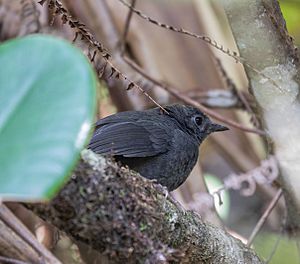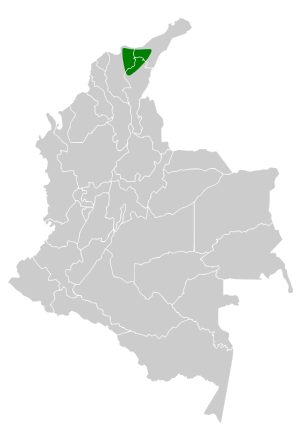Brown-rumped tapaculo facts for kids
Quick facts for kids Brown-rumped tapaculo |
|
|---|---|
 |
|
| In Magdalena, Colombia | |
| Conservation status | |
| Scientific classification | |
| Genus: |
Scytalopus
|
| Species: |
latebricola
|
 |
|
The brown-rumped tapaculo (Scytalopus latebricola) is a small bird that belongs to the family Rhinocryptidae. This special bird lives only in Colombia.
Contents
About the Brown-rumped Tapaculo
The brown-rumped tapaculo is a unique bird species. Even though some other tapaculos were once thought to be its subspecies, scientists now consider it a species all on its own.
What Does It Look Like?
This bird is about 11.5 cm (4.5 in) long. Adult brown-rumped tapaculos have dark brownish-gray feathers on their upper bodies. Their rump, which is the area above their tail, is a warm tawny brown color.
Their throat, chest, and belly are a lighter shade of the same brownish-gray. The sides of their body and lower belly are a bright reddish-chestnut color. Sometimes, these areas might even have dark, bar-like patterns. Young tapaculos are brown and have a striped look.
Where Does It Live?
The brown-rumped tapaculo lives in the mountains of northern Colombia. You can find it in the Sierra Nevada de Santa Marta, a special mountain range that is separate from others. These birds live at high altitudes, usually between 2,000 and 3,660 m (6,560 and 12,010 ft) above sea level.
They prefer to live in thick, damp forests, especially in the dense plants close to the ground. They can be found in both natural mountain forests and forests that have grown back after being cut down.
How It Behaves
What It Eats
The brown-rumped tapaculo mostly stays on the ground. However, it can also climb up tree trunks that are covered in vines. Scientists believe it eats arthropods, which are creatures like insects and spiders.
Family Life
Scientists are still learning about how the brown-rumped tapaculo raises its young. There is some information, but it is a bit confusing. For example, some adult birds that looked like they had just finished breeding were found in July. But young birds changing into their adult feathers were found in March. This means more research is needed to fully understand their breeding season.
Its Conservation Status
The IUCN (International Union for Conservation of Nature) has listed the brown-rumped tapaculo as "Near Threatened." This means that while its population seems stable right now, it lives in a small area that is also broken up into smaller pieces. Because of this, it needs to be watched carefully to make sure its numbers do not drop.
See also
 In Spanish: Churrín ratona para niños
In Spanish: Churrín ratona para niños


